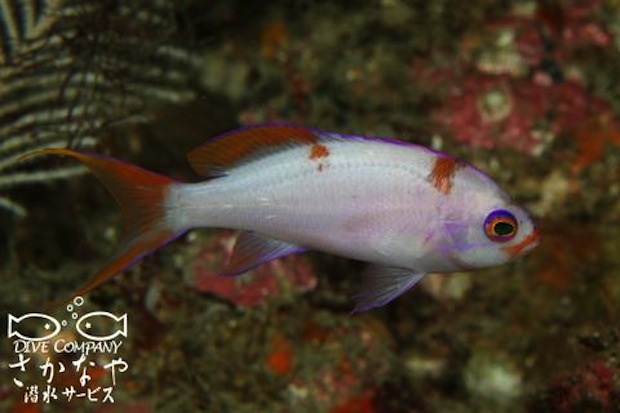We’ve mentioned briefly before that the genus Pseudanthias, and anthias in general, are not prone to hybridisation and aberrations. Despite making their presence deeply felt by occupying almost every square inch of coral reef in shallow water, and even being found at twilight zone depths, very few hybrids or aberrant individuals have ever been documented both in the wild or in the trade.

In the very beginning of this year, we saw isolated reports of several aberrant “ghost anthias” appearing out of Bali. Faithful readers of Reef Builders may remember, but incase you’ve forgotten, the hyperlink above will toggle your memory. These purplish pale ghostly anthias’ are some of the few aberrations we’ve ever seen, and we’re still unsure of what the species being afflicted by the mutation is.

We’ve just stumbled upon images from Sakanaya’s dive blog showing a series of pictures depicting an anthias with an uncanny resemblance to our ghostly individuals. The first picture headlining this article shows a similar fish, with a white body, that purple eye ring and the same spooky purplish fins. However unlike the ones that have appeared in the trade, this individual differs in two things.

Firstly, this documentation of the ghost anthias takes place in Japan, whereas the ghost anthias that appear in the trade so far came from Indonesia. Secondly, the individual shown here is clearly larger than the one we’ve seen entering the trade. These series of photos have been taken over a three month period, and throughout the collection it is clear that the fish is slowly losing the white, and gaining back its original colour. In other words, losing the ghost in ghost anthias.

Yet it is still rather unclear exactly what anthias this is. We know it started out as an aberration, we know it’s not a new species, and we know that as it grows and loses the white, its base colour is orange-red. What causes such aberrations is still unclear. Was the fish born this way? If so, why? And why does it change back to normal as it matures? Can it revert back to normal? It’s common to see such aberrations change back to the wild type in captivity, but it’s just confusing when they’re playing their own musical chair switch-a-roo from start to end in the wild.

The diver is still documenting the change in this particular anthias as we are typing this. His latest picture however shows that the fish is now almost an adult, and has lost much of the white. It’s easier to make out now that this fish is a female form of the japanese Pseudanthias leucozonas.

So now begs the question. What is the identity of the ghost anthias from Indonesia? Could the ghost anthias in Indonesia be the same species with the same aberration as the one in Japan? Indonesia is home to a very similar anthias, which up till recently was unseparated from the true japanese P. leucozonas. We’ve reported trade imports of these Indonesian leucozonas anthias before, but in 2012, Allen and Erdmann revised these Indonesian specimens and separated them from their japanese counterparts. The Indonesian species is now known as Pseudanthias mica.

Seeing as Pseudanthias leucozonas from Japan and P. mica from Indonesia are super closely related and almost indistinguishable, could they both be afflicted by this “ghost” aberration? We’ve seen the documentation of this mutation in both species, assuming they are indeed P. leucozonas and P. mica. Could the similarity in aberration link these two species together?
So many unanswered questions and perhaps even more now that we’re starting to see pictures from Sanakaya’s dive blog. Keep checking Reef Builders and Sakayana for updates on that japanese ghost anthias. The world of fish mutation and colour aberration is so poorly known, and begs for more research and studies to be done! But until then, it’s a vestigial arm of the rare fish section that keeps us excited and on our toes!



